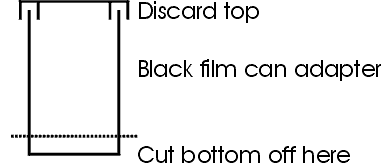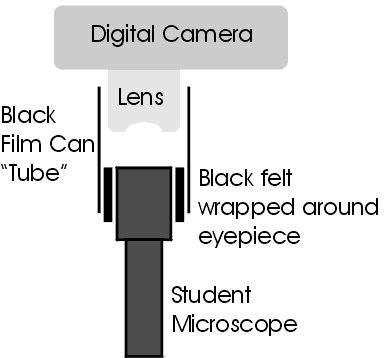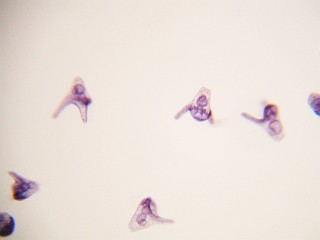Digital Cameras
2/12/2004
Digital cameras are an incredible
enhancement to the classroom. Images of lab setups, results, microscope images,
and the people in the group can all be recorded and included in a report by
the student. No processing time or expense are involved over what is already
in the modern classroom.
However, microscope adapters can
sometimes be non existent or very expensive. A simple adapter can be made from
a discarded Kodak film can [the solid black ones, not the clear ones]. Often
times camera stores will have drawers full of them and are happy to part with
a few.
 |
Remove and discard the top.
Cut off the bottom with a knife [teacher does this] or small saw.
[Cross sectional views]
|
 |
The adapter is then assembled
using some black felt from a craft store or art department. Wrap a strip
of felt around the eyepiece of the microscope till it is big enough for
the film can "tube" to fit snuggly. Insert the digital camera
lens on top. You may have to zoom the digital camera to avoid a "circle"
image.
|
WARNING:
this is not a secure set up and will not support the camera. It is intended
to allow for images to be made by holding the camera in the correct position
above the microscope in a light tight manner. Some experimenting may be necessary.
Sample
image: [prepared slide from Ward's Scientific, 92 W 8331, $4.25]
 |
10X objective and 10X eyepiece
student grade microscope
Contrast enhanced in computer
afterwards
|
Teacher Setup
As a teacher you might want to have
a "good" setup for your microscope. Here are a couple of web sites
that will help. The adapter is not cheap, around $300, but it is professional
and will allow images as good as your optics can handle and it is capable of
leaving the camera on the microscope. Most digital cameras will allow continuous
video feed to a monitor or LCD projector allowing you to demo things to the
class as a whole and record images of anything interesting for later review.
For digital camera reviews see:
http://www.dpreview.com/reviews/specs.asp
The adapters are made by Martin Metallugical
at:
http://martinmetsupply.com/Cameras%20and%20Adaptors.htm
A good site to match up a camera
with an adapter is:
http://microscope-depot.com/digadapt.asp
We have used the Nikon Coolpix 995
[no longer available] with the MMCOOL adapter and have been very happy with
the results. Which brings up the question of megapixels [MP]. Generally the
more megapixels the higher the cost. No point in a student camera being above
2 MP, even 1.3 MP would work well. Their scopes just aren't capable of higher
resolution. For the teacher scope, 3 MP is more than enough.


